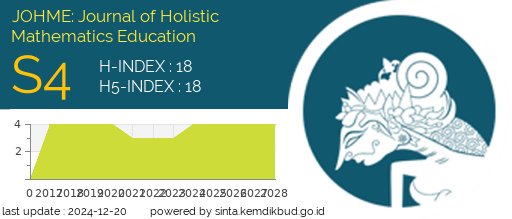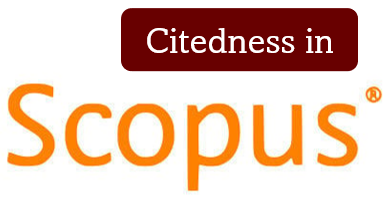PENERAPAN METODE TEAM TEACHING DALAM PEMBELAJARAN MATEMATIKA DI SMA KRISTEN ABC SUKOHARJO [THE IMPLEMENTATION OF THE TEAM TEACHING METHOD IN LEARNING MATHEMATICS AT ABC CHRISTIAN HIGH SCHOOL IN SUKOHARJO]
DOI:
https://doi.org/10.19166/johme.v1i2.815Keywords:
team teaching, Semi Full Team Teaching, Mathematics Learning, Pembelajaran MatematikaAbstract
The team teaching method is a teaching method that is carried out by more than one teacher in a group of similar students by distributing their tasks, watching over them with one and another, evaluating the lesson, and complimenting each other to increase the learning outcomes of the students. The aims of this research was to analyze the implementation of the team teaching method in mathematics learning at ABC Christian High School in Sukoharjo. Mathematics aims to deepen students' understanding of God's creation and how it helps them to fulfill their calling. The research was conducted from July 18, 2016, to November 4, 2016. The subjects were the vice principal, mathematics teachers, and 29 students. This research was a case study research about the implementation of the team teaching method in mathematics learning at ABC Christian High School in Sukoharjo. The research instruments used were interview and documents. The results showed that the implications of the team teaching method were a semi full team teaching, where the teacher teaches with a division of tasks, materials, and hours in learning mathematics. The team teaching method with material distribution and teaching hours helped to overcome the teachers' situation and the learning needs of mathematics at the school, but students found it difficult to follow the teaching team's method as they were studying two different topics in a week.
BAHASA INDONESIA ABSTRAK: Metode team teaching adalah metode pembelajaran yang dilaksanakan oleh lebih dari satu orang guru pada sekelompok siswa yang sama dengan cara membagi tugas, bersama-sama mengamati siswa, mengevaluasi pengajaran dan saling mendukung untuk meningkatkan hasil belajar siswa. Tujuan penelitian ini untuk mengetahui penerapan metode team teaching dalam pembelajaran matematika di SMA Kristen ABC Sukoharjo. Matematika bertujuan untuk memperdalam pengertian siswa tentang ciptaan Allah dan bagaimana pengertian itu membantu mereka untuk memenuhi panggilan mereka. Penelitian dimulai sejak tanggal 18 Juli 2016 sampai 4 November 2016. Subjek penelitian yaitu wakil kepala sekolah bidang kurikulum, guru matematika sebanyak empat orang, dan siswa sebanyak 29 siswa. Penelitian ini merupakan penelitian kualitatif studi kasus tentang penerapan metode team teaching dalam pembelajaran matematika di SMA Kristen ABC Sukoharjo. Instrumen penelitian yang digunakan adalah wawancara, observasi sebanyak tujuh belas kali dan dokumen. Hasil analisis data menunjukkan bahwa metode team teaching yang diterapkan di SMA Kristen ABC Sukoharjo merupakan semi full team teaching, dimana guru mengajar dengan pembagian tugas, materi dan jam pada pembelajaran matematika. Metode team teaching dengan pembagian materi dan jam mengajar membantu mengatasi keadaan guru dan kebutuhan pembelajaran matematika di sekolah tersebut, namun siswa kesulitan mengikuti penerapan metode team teaching karena mempelajari dua topik yang berbeda dalam seminggu.
References
Ahmadi, R. (2016). Metodologi penelitian kualitatif. Yogyakarta, Indonesia: Ar-Ruzz Media.
Buckley, F. J. (2000). Team teaching: What, why and how? London, UK: Sage Publication. DOI: http://dx.doi.org/10.4135/9781452220697.n1
Goetz, K. (2000). Perspectives on team teaching. EGallery: Exemplary Students Scholarship, Master of Teaching Program, Faculty of Education, 1(4). Retrieved from http://people.ucalgary.ca/~egallery/goetz.html
Jang, S. J. (2006). Research on the effects of team teaching upon two secondary school teachers. Educational Research, 48(2), 177-194. DOI: https://doi.org/10.1080/00131880600732272
Kisworo. (2000). Team teaching alternatif pembelajaran IPA yang memberi otonomi siswa. Jurnal Ilmiah Guru Caraka Olah Pikir Edukatif, 4 (2), 5-10. Retrieved from https://journal.uny.ac.id/index.php/cope/article/view/5333/4637
Knight, G. R. (2009). Filsafat dan pendidikan. Jakarta, Indonesia: Universitas Pelita Harapan.
Kusyairi. (2012, May 20). Pengaruh metode pembelajaran group teaching terhadap keterampilan berbicara siswa [Website]. Retrieved from http://www.infodiknas.com/pengaruh-metode-pembelajaran-group-teaching-terhadap-keterampilan-berbicara-siswa-sma.html
Parapak, J. (2002). Pembelajar dan pelayanan di sekitar iman, teknologi, pendidikan dan pelayanan gerejawi. Jakarta, Indonesia: Institut Darma Mahardika.
Rabb, R. (2009). Team teaching. Retrieved from https://www.usma.edu/cfe/literature/rabb_09.pdf
Reys, R. E., Lindquist, M. M., Lambdin, D. V., & Smith, N. L. (2006). Helping children learn mathematics. Danvers, MA: Wiley.
Slavin, R. E. (2008). Psikologi pendidikan teori dan praktik. Jakarta, Indonesia: Indeks.
Stewart, T., & Perry, B. (2005). Interdisciplinary team teaching as a model for teacher development. Teaching English as a Second or Foreign Language, 9(2), 1-16. Retrieved from https://eric.ed.gov/?id=EJ1065845
Sugiyono, P. D. (2013). Metode penelitian kuantitatif dan R&D. Bandung, Indonesia: Alfabeta.
Supatmono, C. (2009). Matematika asyik. Jakarta, Indonesia: Grasindo.
Van Brummelen, H. (2009). Berjalan dengan Tuhan di dalam kelas. Tangerang, Indonesia: Universitas Pelita Harapan.
Wulandari, T. R. (2013). Philosophy of team teaching and learning. Jurnal Ilmiah Bina Bahasa 6(2), 57-56. Retrieved from http://eprints.binadarma.ac.id/2179/1/Philosophy%20of%20Team%20Teaching.pdf
Downloads
Published
How to Cite
Issue
Section
License
Authors who publish with this journal agree to the following terms:
1) Authors retain copyright and grant the journal right of first publication with the work simultaneously licensed under a Creative Commons Attribution License (CC-BY-SA 4.0) that allows others to share the work with an acknowledgement of the work's authorship and initial publication in this journal.
2) Authors are able to enter into separate, additional contractual arrangements for the non-exclusive distribution of the journal's published version of the work (e.g., post it to an institutional repository or publish it in a book), with an acknowledgement of its initial publication in this journal.
3) Authors are permitted and encouraged to post their work online (e.g., in institutional repositories or on their website). The final published PDF should be used and bibliographic details that credit the publication in this journal should be included.”










